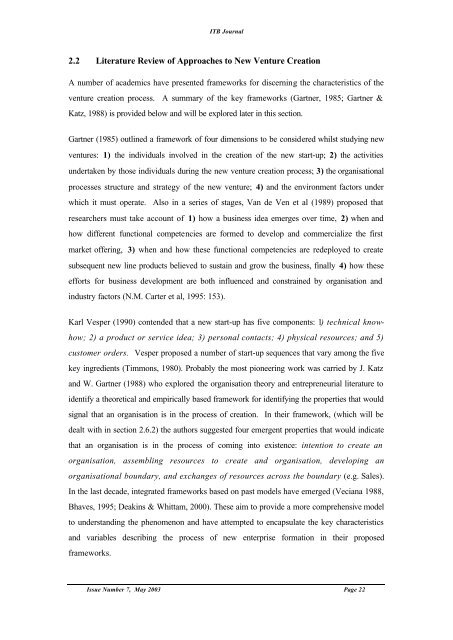ITB Journal-May-2003 - Institute of Technology Blanchardstown
ITB Journal-May-2003 - Institute of Technology Blanchardstown
ITB Journal-May-2003 - Institute of Technology Blanchardstown
Create successful ePaper yourself
Turn your PDF publications into a flip-book with our unique Google optimized e-Paper software.
<strong>ITB</strong> <strong>Journal</strong><br />
2.2 Literature Review <strong>of</strong> Approaches to New Venture Creation<br />
A number <strong>of</strong> academics have presented frameworks for discerning the characteristics <strong>of</strong> the<br />
venture creation process. A summary <strong>of</strong> the key frameworks (Gartner, 1985; Gartner &<br />
Katz, 1988) is provided below and will be explored later in this section.<br />
Gartner (1985) outlined a framework <strong>of</strong> four dimensions to be considered whilst studying new<br />
ventures: 1) the individuals involved in the creation <strong>of</strong> the new start-up; 2) the activities<br />
undertaken by those individuals during the new venture creation process; 3) the organisational<br />
processes structure and strategy <strong>of</strong> the new venture; 4) and the environment factors under<br />
which it must operate. Also in a series <strong>of</strong> stages, Van de Ven et al (1989) proposed that<br />
researchers must take account <strong>of</strong> 1) how a business idea emerges over time, 2) when and<br />
how different functional competencies are formed to develop and commercialize the first<br />
market <strong>of</strong>fering, 3) when and how these functional competencies are redeployed to create<br />
subsequent new line products believed to sustain and grow the business, finally 4) how these<br />
efforts for business development are both influenced and constrained by organisation and<br />
industry factors (N.M. Carter et al, 1995: 153).<br />
Karl Vesper (1990) contended that a new start-up has five components: 1) technical knowhow;<br />
2) a product or service idea; 3) personal contacts; 4) physical resources; and 5)<br />
customer orders. Vesper proposed a number <strong>of</strong> start-up sequences that vary among the five<br />
key ingredients (Timmons, 1980). Probably the most pioneering work was carried by J. Katz<br />
and W. Gartner (1988) who explored the organisation theory and entrepreneurial literature to<br />
identify a theoretical and empirically based framework for identifying the properties that would<br />
signal that an organisation is in the process <strong>of</strong> creation. In their framework, (which will be<br />
dealt with in section 2.6.2) the authors suggested four emergent properties that would indicate<br />
that an organisation is in the process <strong>of</strong> coming into existence: intention to create an<br />
organisation, assembling resources to create and organisation, developing an<br />
organisational boundary, and exchanges <strong>of</strong> resources across the boundary (e.g. Sales).<br />
In the last decade, integrated frameworks based on past models have emerged (Veciana 1988,<br />
Bhaves, 1995; Deakins & Whittam, 2000). These aim to provide a more comprehensive model<br />
to understanding the phenomenon and have attempted to encapsulate the key characteristics<br />
and variables describing the process <strong>of</strong> new enterprise formation in their proposed<br />
frameworks.<br />
Issue Number 7, <strong>May</strong> <strong>2003</strong> Page 22
















